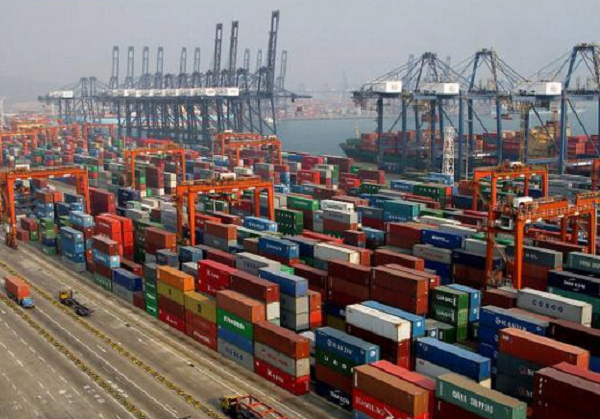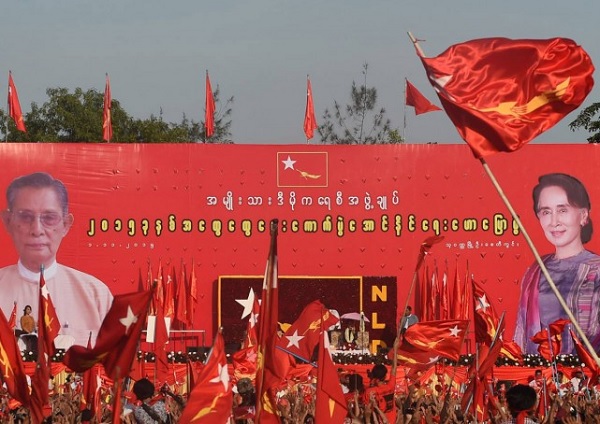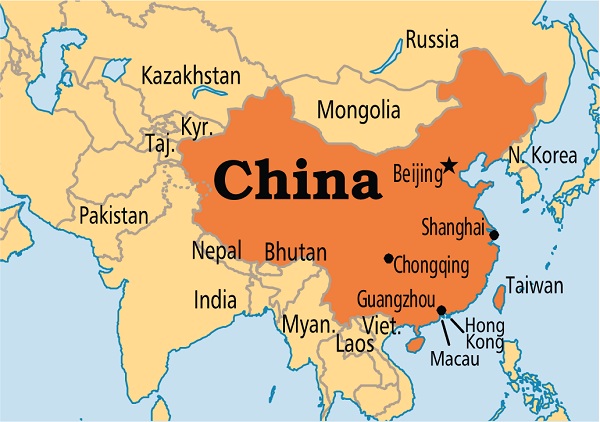
by Editor | May 25, 2021 | World
 Beijing, (IANS) China’s exports rose 4.1 percent year on year in April while imports dipped 5.7 percent, customs data showed on Sunday.
Beijing, (IANS) China’s exports rose 4.1 percent year on year in April while imports dipped 5.7 percent, customs data showed on Sunday.
It led to a monthly trade surplus of 298 billion yuan ($45 billion), up from March’s 194.6 billion yuan, according to figures from the General Administration of Customs, reports Xinhua news agency.
The export growth in April was milder than the 18.7 percent increase in March, while imports fell at a faster pace compared with the 1.7 percent fall in the previous month.
Foreign trade edged down 0.3 percent year on year to 1.95 trillion yuan last month and that for the first four months combined slipped 4.4 percent to 7.17 trillion yuan.
In the January-April period, exports dropped 2.1 percent year on year while imports went down 7.5 percent, leading to a trade surplus of 1.11 trillion yuan, widening 16.5 percent from a year earlier.
The leading index for the country’s exports rose 2.2 points to 33.8 in April, with sub-indices for new export orders and managers’ confidence both up from March, signalling smaller pressure on export growth in the second quarter.

by Editor | May 25, 2021 | Economy, News
 By Anil Giri
By Anil Giri
Kathmandu : (IANS) With the signing of the Transit and Transportation Agreement between Nepal and China in Beijing, there is a sense of anxiety, worry and concern in Indian strategic circles about Nepal tilting towards China. Many have commented that this has ended India’s long monopoly in Nepal in doing third country business through Indian ports and, overnight, Nepal will do business, import fuel from China and so on.
As a landlocked country, seeking transit rights is Nepal’s fundamental right and, as of now, India and Bangladesh have provided such facilities to Nepal.
Realizing that Nepal will turn to China for transit and trade rights, India, during the visit of Nepalese Prime Minister K.P. Sharma Oli last month, had agreed to provide Visakhapatnam port for Nepal’s use. As of now, Nepal is using only Haldia in Kolkata for third-country trade but it is smaller than Visakhapatnam. During the visit, India also allowed Nepal land transit via Bangladesh, implicit being that India was already aware that Nepal would turn to China.
It is being said that had India allowed Nepal this when it was proposed over a decade ago, Nepal would not have gone with China. Second, if India had not imposed an unofficial blockade, privileging one community and group’s demand, Nepal would not have tilted towards China.
After signing the Transit Agreement with China, it is widely anticipated that Nepal will do business through Chinese ports and end its dependency on India. Such interpretations, particularly in Indian strategic circles, are beyond the ground realities and one should understand that a transit treaty does not necessarily measure up to implementation.
The poor infrastructure on the Nepali side, difficult geographical terrain on both sides and without a rail link up to the Nepali border in Kerung (Gyirong in Chinese side), Nepal cannot immediately begin third country business through Chinese ports. Physical infrastructure in either side of the border is important for full use of transit rights and, on the Nepali side, it will take years to upgrade Kerung, the only transit, transportation and trade route between Nepal and China.
Second, the nearest Chinese port is Tainjin which is 3,000 km from the Nepali border and the nearest Indian port is Haldia which is just 1,000 km away. This per se makes a huge difference in doing business in terms of costs, said Nepal’s former commerce secretary Purusottam Oja.
If Nepal needs to do business through Tainjin port to Kerung, it is almost impossible to import goods via trucks or containers. The only option is by rail and Chinese officials say this will happen only by 2020.
“Of course, a further extension from Gyirong is an even longer-term plan. It’s up to geographic and technical conditions and financing ability. We believe that far in the future the two countries will be connected by rail,” Hou Yanqi, deputy head of the Chinese foreign ministry’s Asia division, said in Beijing after the meeting between Oli and Premier Li Keqiang.
“Strategically it is going to be a good deal but due to distance per se, it is going to be a very costly affair for us until there is rail service from Tainjin to the Nepal border,” said Oja. “It also depends on status of infrastructure in both sides…and paper work. Hassle free paperwork for customs and other purposes are key in transit rights,” said Oja.
Another Nepal-China trading point, Tatopani, is shut down since the April 25, 2015 earthquake and there is no official confirmation whether the Chinese side will open it up or not. In case China opens it, Nepali traders have to use trucks, containers and other light vehicles to import and export goods from Tianjin, again very costly for traders.
“I am not going to use and do business through Tanjian that is going to be three-fold expensive for us,” said Indian trader Ravi Singh, who is engaged in third-country business.
“Without stressing on connectivity, the transit agreement will not be productive,” said noted economist Bishamber Pyakurel.
“Neither it is a historic pact nor is it a non-workable one. Though it is a welcome move, its success lies in implementation,” he said in an interaction with journalists.
It should also be remembered that Nepal is doing business with India through 24 small and big trading points whereas Nepal is doing business with China only through one trading point.
Then, India has also proposed to build five rail corridors with Nepal and one is proposed to connect Uttar Pradesh and Kathmandu.
The ground realities more than make clear that the ‘China card’ remains more of an illusion but Kathmandu has finally made the strategic move that New Delhi is bound to have taken note of.
(Anil Giri can be contacted at girianil@mail.com.)

by Editor | May 25, 2021 | Opinions
 By Amitava Mukherjee
By Amitava Mukherjee
Even as the Aung San Suu Kyi-led National League for Democracy (NLD) is expected to form a new government in Myanmar, China has lost no time in diagnosing the import of the party’s victory and is all set to recalibrate its policy towards the country to steal a march over India towards gaining a deeper strategic depth in this ASEAN nation.
China’s standpoint became clear when Chinese Foreign Minister Wang Yi said in the middle of November that his country expects Myanmar to continue its friendly relations with Beijing although a new dispensation is set to emerge in Naypyidaw.
China has reasons to feel uncomfortable as Suu Kyi has close personal bonds with India. General Aung San, her father and the legendary Burmese liberation hero, enjoyed close personal relationship with the Indian political leadership. Suu Kyi herself spent a good amount of her life in Delhi. She studied first in the Jesus and Mary Convent and then in Lady Shri Ram college.
Because of this fact, China had extended her a warm reception in Beijing in June when President Xi Jinping had met her, breaking protocol.
The ground reality is that China is way ahead of India in matters of strategic depth in Myanmar. In a classic example of establishing relationships with the Indian Ocean littoral states, China has recently constructed two pipelines originating at Kyaukpyu in Myanmar and terminating in Kunming for transporting oil and gas. The purpose is to lessen reliance on the route passing through the Malacca Strait.
Given Myanmar’s strategic importance in South Asia, China has been constantly increasing its economic footprint in the country. Last year China’s cumulative foreign direct investment in Myanmar stood at $14 billion. Bilateral trade reached $6 billion in 2013 while the corresponding figure for India-Myanmar trade was around $2 billion.
Most probably, any government led by Suu Kyi will try to maintain a balance in its relations with the two Asian giants. But the task for her will be difficult because while China acts, India deliberates and dithers. A tell-tale example of this is the Kaladan Multi-modal Transport Project which envisages connectivity between the Indian ports in the east and Myanmar’s Sittwe port – along with river and road connectivity with Mizoram. The project was scheduled to be completed in 2013, but is delayed due to slow river engineering works.
In spite of delays in some India-sponsored projects the race for leverage over Myanmar is going to be intense and interesting. New Delhi has worked out high speed data links in 32 cities of Myanmar and several Indian companies like ESSAR, GAIL and ONGC Videsh Ltd. have invested in the country’s energy sector. Most importantly, India has extended duty-free tariff preference to Myanmar.
It is true that compared to China, India’s trade with Myanmar has been showing a tardy trend. But from a paltry $12.4 million in 1981 to a little more than $2 billion in 2013 is certainly not bad progress.
Moreover, the balance of trade is in favour of Myanmar by 4:1. It mostly exports to India primary agricultural products like beans, pulses and forest products while India sends pharmaceutical products, steel and iron goods, electrical machinery, mineral oil, and rubber products, among others.
But India’s concern should lie in the development and utilization of the huge energy reserves that Myanmar possesses. The country has the world’s biggest gas reserves – estimated to be more than 90 trillion cubic feet. Myanmar has apportioned the job of exploration and development of oil and gas fields to companies of various countries like the China National Petroleum Corporation (CNPC), Daewoo (South Korea), Itera(Russia), ONGC Videsh and GAIL (India), among others. In the same vein, Myanmar chose China, instead of India, for supplying 6.5 trillion cubic feet of natural gas for 30 years beginning from 2005.
India is desperately trying to catch up. The UPA-2 government (2009-14) extended a new $500 million credit line in addition to an existing $300 million line. The same government had targetted bilateral trade of $3.5 billion in 2015. Whether the target has been met remains an open question.
The two sides are now also showing interest in military cooperation. During his visit to India in June, Senior General Min Aung Hlaing, the commander-in-chief of the Myanmar army, had shown keen interest in purchasing offshore patrol vessels.
There are 400,000 people of Indian origin living in Myanmar. There are also Chinese-origin people, particularly in the northern parts. Both China and India have very high security interests and a tug-of-war is inevitable. It is to be seen how the new government in Myanmar tackles this – because it is a hard choice to make.
Amitava Mukherjee is senior journalist and commentator. The views expressed are personal. He can be contacted at amukherjee57@yahoo.com

by Editor | May 25, 2021 | World
 Beijing:(IANS) China has unveiled a 140 billion yuan ($22 billion) plan for upgrading its internet infrastructure and the development of its logistics industry in rural areas, the media reported on Thursday.
Beijing:(IANS) China has unveiled a 140 billion yuan ($22 billion) plan for upgrading its internet infrastructure and the development of its logistics industry in rural areas, the media reported on Thursday.
A meeting of the State Council presided over by Prime Minister Li Keqiang on Wednesday decided to allocate more central government funds to building internet infrastructure and also advocated funding from local governments and social organisations, the China Daily reported.
A circular issued after the meeting said the government plans to invest up to 140 billion yuan in the sector by 2020 to provide at least 50,000 villages with internet access. By then, about 98 percent of the nation’s rural areas will be provided with internet access.
The government also promised to improve internet speed and expand wireless broadband coverage in areas.
Estimates of China’s rural population range from 600 million to 800 million.
The meeting also pledged to expand e-commerce apps in rural areas, especially in promoting agricultural products and trips to the countryside.
The government will also open up the delivery industry to social investors, encourage mergers and acquisitions and streamline customs procedures for cross-border deliveries.

by Editor | May 25, 2021 | Corporate, Corporate Governance
 By Anil Giri
By Anil Giri
Kathmandu:(IANS) Nepal has urged China to reopen the two trading points on the Sino-Nepal border at the earliest amid problems along the border with India, media reports said on Friday.
Amid a diplomatic standoff with New Delhi over Nepal’s new constitution and continuous unrest in the country’s southern border with India, Kathmandu is now mulling an alternative to do business with China.
India and China are landlocked Nepal’s two giant neighbours.
Nepal is surrounded by India from three sides and China on the north. Nepal’s over 90 percent trade and economic activities are with India as nationals from both sides do not need visa to travel to each other’s country.
According to Nepali media reports on Friday, with the supply of essential commodities being hit by disturbances at major custom points in the southern plains, the government has urged Beijing to reopen trade routes that have remained out of operation following the April 25 earthquake.
Officials from the ministry of commerce and supplies of Nepal held talks with Chinese embassy officials here on Wednesday and Thursday.
They requested Chinese assistance for an early reopening of custom points at Tatopani and Rasuwagadhi, two key trading points between Nepal and China.
“With major festivals like Diwali and Dussehra around the corner, we have requested China to resume border operation as soon as possible,” said Naindra Prasad Upadhyaya, secretary at the ministry.
He added that the Chinese authorities had responded positively.
The Rasuwagadhi route came into formal operation in December 2014. Since the April earthquake, the trade routes of Barabise-Tatopani-Khasa and Nuwakot-Rasuwagadhi-Kerung have remained closed.
According to the ministry, the Chinese government has been undertaking road repair on its side of the border.
“We are ready to open the border as soon as the Chinese side completes work on their end.”
Upadhyaya said a meeting of the Central Monitoring Committee of Nepal on Thursday also decided to ask China for speedy road repair in Kerung (Rasuwagadhi).
The meeting also decided to coordinate with the ministry of physical infrastructure and transport to clear roadblocks on the Araniko highway in order to request the Chinese side to reopen the Tatopani customs point.
The initiative comes at the time when supplies from India have been affected by strikes in the Tarai region for the past 40 days.
In addition, tighter customs clearance and other delays reportedly from the Indian side after the promulgation of Nepal’s new constitution have magnified the problem.
The current food stock in Nepal is expected to last two months, according to the government.
Nepal imports readymade garments, footwear, cosmetics, machinery parts and hardware, fruits and electronics from China.

 Beijing, (IANS) China’s exports rose 4.1 percent year on year in April while imports dipped 5.7 percent, customs data showed on Sunday.
Beijing, (IANS) China’s exports rose 4.1 percent year on year in April while imports dipped 5.7 percent, customs data showed on Sunday.



